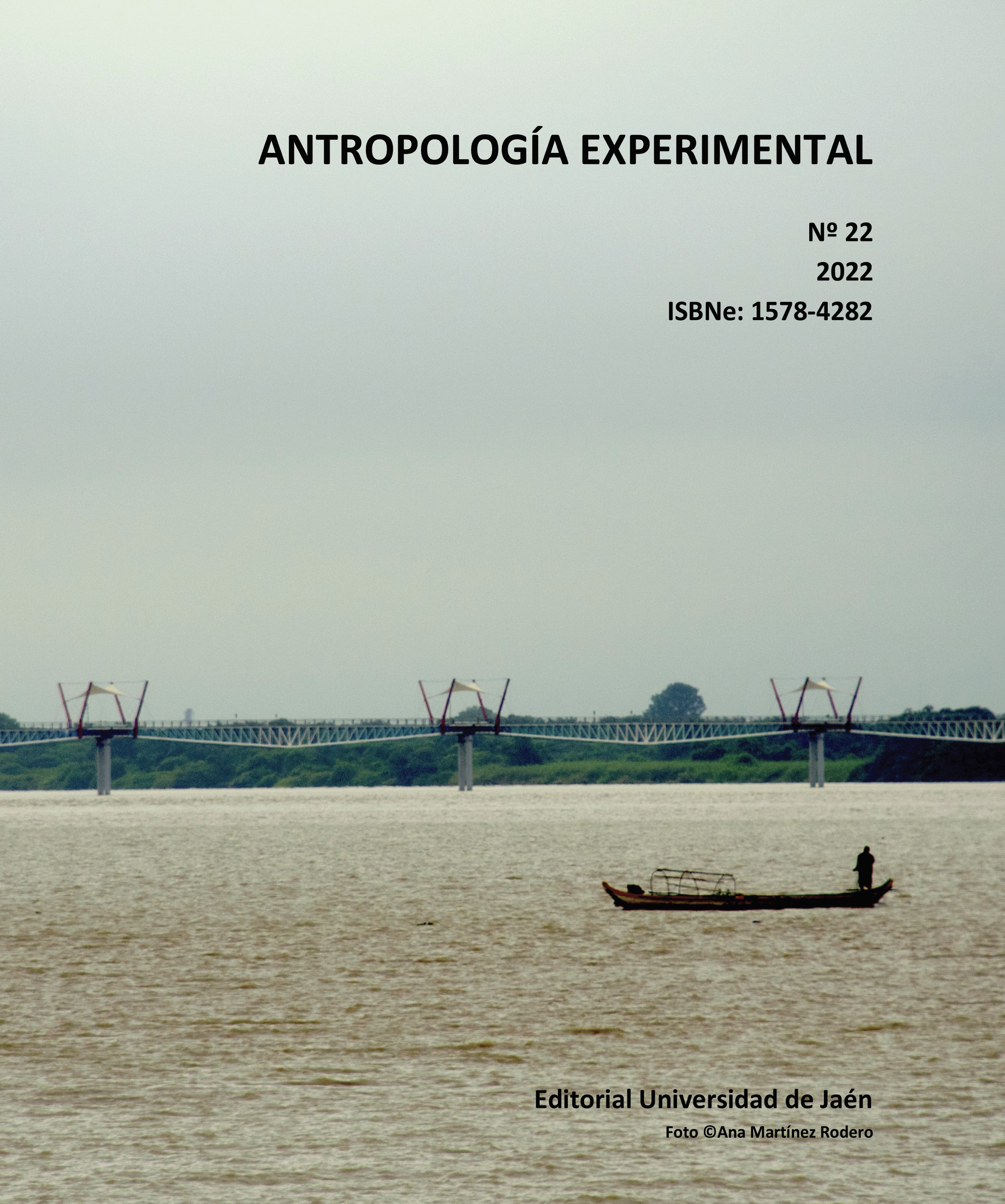Narrative (dis)encounters between cinema and the social sciences
Counterpoint methodological reflections from a documentary experience
DOI:
https://doi.org/10.17561/rae.v22.6945Keywords:
Ethnographic film, Homelessness, Border, Narratives, RepresentationsAbstract
This article presents a series of methodological reflections that point to a narrative dilemma that emerges when working from the linkage of cinematographic processes with ethnographic ones: to show or to explain in the final product. Taking as a starting point the experience of producing a documentary film from a long and ethnographic depth research on deported peoples who inhabit the streets of a border town in northern Mexico, the article elaborates the theoretical-philosophical approach of the inexorability of reality in order to emphasize that the simultaneity of lived time and documented time is the novelty that cinema offers to ethnographic work. It also argues that recreating reality is the possibility offered in film work and, therefore, three forms of representation of border street life in cinema and the social sciences are discussed: meritocratic, victimist and miserabilist. It addresses the possibility of working the local from the ethnographic and the universal from the cinematographic and concludes by highlighting the advantages of the joint work between ethnography and cinema, as well as the role that the viewer can play in that process.
Downloads
References
Del Monte Madrigal, J. A. (2018). “Devenir habitante de calle en una ciudad fronteriza del norte de Méxi-co: deportación, consumo de drogas y violencias”, Civitas. Revista de Ciências Sociais, Vol. 19, Núm. 1, 159-177. https://doi.org/10.15448/1984-7289.2019.1.30700
Del Monte Madrigal, J. A. (2019). “Del retorno forzado a la vida en la calle. La transición a la indigencia en una ciudad fronteriza del norte de México” en Rivera Sánchez, Liliana (ed.) ¿Volver a casa? Migran-tes de retorno en América Latina. Debates, tendencias y experiencias divergentes, COLMEX, México. https://doi.org/10.2307/j.ctv18r6qtz.8
Baker, S. (productor y director) (2017). Proyecto Florida. Estados Unidos: June Pictures y Freestyle Picture Company.
Barbash I, Taylor L. (1996). Reframing Ethnographic Film: A “Conversation” with David MacDougall and Judith MacDougall. American Anthropologist, 98, (2), 371¬-387. https://doi.org/10.1525/aa.1996.98.2.02a00120
Becker, H. (2015). Para hablar de la sociedad, la sociología no basta. México: Siglo XXI.
Bergson, H. (1976). El pensamiento y lo moviente. Madrid: Espasa-Calpe.
Bourgois, P. (2003). En busca de respeto. Vendiendo crack en Harlem. Argentina: Siglo XXI.
Bukantz K. (productora) y Gamou, G. (director) (2014). El regreso del Muerto, [documental], México: CCC.
Clifford, J. (1988). The Predicament of Culture, Twenieth-Century Ethnography, Literature, and Art. Massa-chusetts: Harvard University Press. https://doi.org/10.4159/9780674503724
D’Andrea, A., Ciolfi, L., y Gray, B. (2011). Methodological Challenges and Innovations in Mobility Research. Londres: Mobilities, Routledge. https://doi.org/10.1080/17450101.2011.552769
De Verteuil, G., May, J., Von Mahs, J. (2009). Complexity not collapse: recasting the geographies of home-lessness in a “punitive” age. Progress in Human Geography, 33 (5), 646-666. https://doi.org/10.1177/0309132508104995
Deleuze, G. (2009). Cine i. Bergson y las imágenes. Buenos Aires: Cactus.
Fonseca, C. (2005). La clase y su recusación etnográfica. Etnografías contemporáneas, 1, (1), 117-138.
González-Abrisketa, O. (2014). Recrear la realidad: la irrupción del cine etnográfico en la academia, An-damios, 11 (26), 353-375. https://doi.org/10.29092/uacm.v11i26.208
Gowan, T. (2010). Hobos, hustlers and backsliders. Homeless in San Francisco. Minneapolis: University of Minnesota Press. https://doi.org/10.5749/minnesota/9780816648696.001.0001
Harper, D. (2002). Talking about pictures: a case for photo elicitation. Visual Studies, 17(1), 13-26. https://doi.org/10.1080/14725860220137345
Hue, J-Ch. (productor y director) (2019). Tijuana Bible [película], Francia-México: Les films d’Avalon/AdVitam Production
Jirón, P. (2011). On becoming “la sombra/the shadow” en Büscher, Monika, Urry John y Witcher Katian (eds.), Mobile Methods. Reino Unido: Routledge.
Latour, B. (2008). Reensamblar lo social. Una introducción a la teoría del actor-red, Buenos Aires: Manantial.
Laurier, E. (2010). Being There/Seeing There: Recording and Analysing Life in the Car en Fincham, Ben, McGuinness, Mark y Murray, Lesli, Mobile Methodologies. Reino Unido: Palgrave MacMillan.
Marcus, G. (1998). Ethnography Thruough Thick & Thin. Nueva Jersey: Princeton University Press. https://doi.org/10.1515/9781400851805
Marcus, G; y Fischer, M. (2000). La antropología como crítica cultural. Un momento experimental en las cien-cias humanas. Argentina: Amorrortu Editores.
Massumi, B. (2002). Parables for the Virtual: Movements, Affect, Sensation. Durham, NC: Duke University Press. https://doi.org/10.1215/9780822383574
Morin, E. (1962). “Prefacio” en Heusch, Luc De, Cinema et sciences sociales – Panorama du film ethnographique et sociologique. París: UNESCO.
Rosaldo, R. (2000). Cultura y verdad. La reconstrucción del análisis social. Quito: Ediciones ABYA-YALA.
Rosi, G. (productor y director) (2008). Below See Level [documental]. Estados Unidos: 21 One Productions
Rouch, J. (2003). The Man and the Camera, en Paul Hockings (ed.), Principles of Visual Anthropology, Ber-lin: Mounton de Gruyter.
Silva, R.(director). (2014). Navajazo [documental/cine dramático], México: Interior XIII.
Sontag, S. (1984). Contra la interpretación y otros ensayos. Barcelona: Seix Barral.
Vice, Wolderberg L. (productora) y Loyola B. (director). (2016). El purgatorio de los deportados [documen-tal], Estados Unidos: Vice Media Inc.
Downloads
Published
Issue
Section
License
Copyright (c) 2022 Juan Antonio Del Monte Madrigal

This work is licensed under a Creative Commons Attribution 4.0 International License.
Responsabilidad de los autores: son responsables por las ideas y datos empíricos de los manuscritos, por la fidelidad de la información, por la corrección de las citas, por los derechos para publicar cualquier material incluido en el texto y por la presentación del manuscrito en el formato requerido por la Revista de Antropología Experimental. Un manuscrito enviado a la Revista de Antropología Experimental no debe estar publicado ni haber sido presentado en la misma forma a otro medio de publicación. Así, mismo, los autores reconocen que conocen y están de acuerdos con estas PAUTAS EDITORIALES Y FORMALES. La dirección de la Revista de Antropología Experimental está permanentemente abierta para aclarar cualquiera de los contenidos aquí citados u de cualquier otra índole que surjan en el proceso de publicación de los manuscritos.






